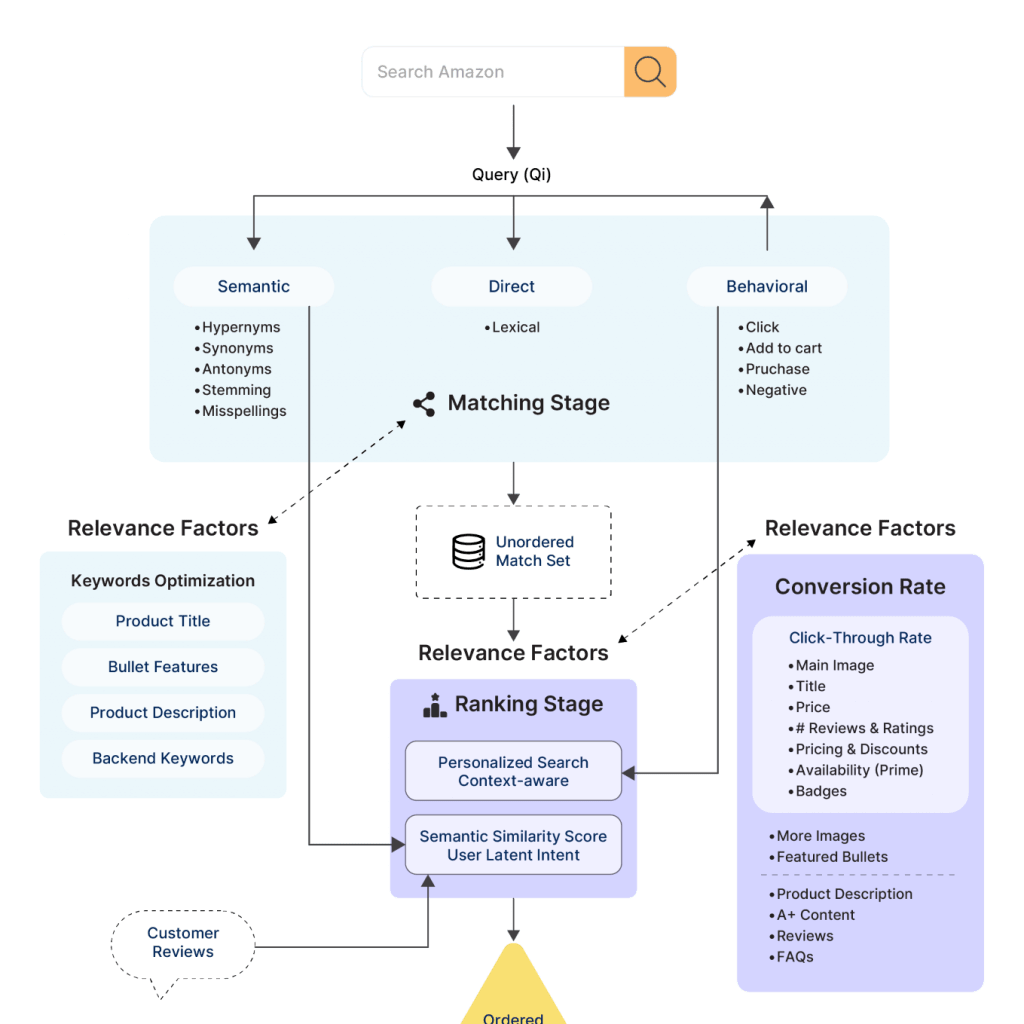
Every Amazon seller aims for the #1 spot in search results. While many sellers know how Amazon ranks products, few truly understand what drives those rankings. Once you understand how the Amazon A9 algorithm works, it can completely shift the way you approach your product listings.
When you understand how the Amazon A9 search algorithm evaluates, matches, and ranks products, you can tailor your strategy to put you ahead of the competition. It’s more than just using keywords; it’s about creating listings that resonate with the Amazon A9 search algorithm and your customers.
In this guide, we’ll learn how the A9 Amazon algorithm works, what factors matter most, and how you can optimize every part of your listing to boost visibility, earn more clicks, and drive more sales.
What Is Amazon’s A9 Ranking Algorithm?
Amazon’s powerful search engine, commonly referred to as A9 search algorithm, originated from A9.com, a subsidiary that focused on search technologies. Over the years, the Amazon A9 algorithm has evolved into a smart, highly refined system designed to help shoppers quickly find the most relevant and personalized product results.
Unlike traditional search engines that rely on backlinks or page authority, the Amazon A9 algorithm focuses on sales performance. It rewards product listings that earn clicks, turn browsers into buyers, and create a smooth, satisfying shopping experience. In other words, it’s a performance-first, customer-focused system that favors listings that get results.
How Does Amazon’s Search Algorithm Work?
The Amazon search ranking algorithm works through two fundamental stages: matching and ranking.
- Matching: Amazon matches a customer’s query to relevant products using keywords and semantic signals.
- Ranking: It then ranks those matched products based on how well they are expected to perform (clicks, conversions, past behavior, etc.).

The Matching Stage
When a shopper types something into Amazon’s search bar, the platform starts its work instantly to find the most relevant products. The first step, the matching stage, is all about identifying which listings are in the running. Here’s how A9 evaluates relevance:
1. Direct Matching
Amazon begins by looking for products using the same words used in the search. So, if someone searches for “wireless headphones,” listings that use that exact phrase or even just the individual words will appear first. This is the simplest form of matching, and it’s only scratching the surface because shoppers don’t always use the same words sellers do.
2. Semantic Matching
Amazon’s A9 algorithm adds a layer of intelligence to go beyond exact text matches. It understands the meaning behind words. That’s where semantic matching comes in. Semantic search ensures that even if customers do not use the right word, they still receive relevant results.
Here’s how A9 reads between the lines:
- Synonyms (e.g., “sneakers” and “trainers”)
- Hypernyms (e.g., “menswear” as a broader term for clothing or accessories)
- Antonyms and Variations
- Stemming (e.g., “run” from “running”)
- Misspellings or Typos
3. Behavioral Data Matching
Amazon constantly learns from customer behavior to refine product matches. If a certain product gets clicked frequently and has a strong purchase rate, it’s more likely to appear in future searches. Behavioral signals include:
- Clicks
- Add-to-cart actions
- Purchases
- Bounces or no engagement (a red flag)
The Ranking Stage
Once Amazon identifies all the relevant listings, it needs to sort them. This evaluates listings using past performance and customer behavior to rank the products in search results.
1. Understanding User Intent
Shoppers don’t always use the perfect words to find what they want. Amazon’s A9 ranking algorithm read between the lines. It analyzes various keywords, browsing patterns, and other information to understand what the shopper wants.
For example, if someone searches for “men’s running shoes,” the algorithm doesn’t just scan for those exact words. It focuses on listings, including related activities (running, jogging, marathons) and target demographics (men and athletes).
Customer reviews also help. If your reviews frequently mention “CrossFit,” the A9 Amazon ranking algorithm will start ranking your product with CrossFit-related searches.
2. Handling the Visibility Challenge
New listings often struggle to gain traction because they haven’t built engagement data. Amazon employs Learning-to-Rank (LTR) models to address this. Sellers can boost this early visibility through promotions, deals, and Amazon ads (PPC). These models predict product performance by analyzing a combination of:
- Prior Values: Early assumptions (e.g., listing quality, price, keyword relevance)
- Posterior Values: Actual behavior after your listing goes live
3. Context-Aware Search
Amazon customizes search results based on shopper’s behavior. This context-aware approach helps the A9 algorithm refine results. As a seller, it’s important to understand your product’s context. Is it a luxury item or a budget-friendly solution? Use words in your listings that indicate keywords like “premium,” “eco-conscious,” “minimalist,” or “family-size” to help match with the right audience.
For example:
- A user who regularly shops for luxury goods might see high-end handbags ranked higher in the list, even if they don’t buy them often (because window shopping behavior is expected).
- If a shopper has previously bought Nike products, they may be shown Nike listings that are higher in results.
Key Ranking Factors of the A9 Algorithm
The Amazon A9 algorithm evaluates two major categories to rank listings:
1. Relevance Indicators
These factors help Amazon understand whether your product is a good match for a customer’s search. You can improve your visibility by optimizing following:
- Product Title: Place your most important keywords at the beginning, making it clearer, more concise, and more relevant to shoppers’ search.
- Bullet Points: Highlight the important features and benefits related to product usage.
- Description: Provide in-depth details, technical aspects, USPs, and other important information to help the shoppers.
- Backend Search Terms: Include alternative keywords, misspellings, and related terms that don’t fit naturally into visible content.
2. Performance Indicators
Once Amazon knows your product is relevant, it looks at how customers engage with your listing. Performance metrics help boost your visibility.
Click-Through Rate (CTR)
A higher CTR tells A9 that shoppers find the listing engaging and relevant enough. Boost your CTR by:
- Using clear, professional images
- Writing concise, keyword-rich titles
- Offering competitive prices or discounts
- Encouraging positive reviews
- Leveraging Prime shipping and Amazon badges (e.g., “Best Seller”)
Conversion Rate (CR)
A strong conversion rate tells Amazon that shoppers aren’t just browsing, they’re buying. Increase CR with:
- Include multiple high-quality product images with different angles
- Well-written bullet points and detailed descriptions
- Adding A+ Content with enhanced visuals and infographics
- Displaying user-generated reviews and FAQs
- Clearly communication shipping options, return policies, and warranty info
Optimize for Performance with a Proven Amazon Strategy
Mastering Amazon’s A9 algorithm is one of the smartest moves as a seller, and with Second Office, you can optimize keywords, craft compelling listings, and decode shopper behavior faster.
We help you build relevance through strategic keyword research and high-converting content. Then, we drive performance by improving click-through rates, boosting conversions, and refining your listings based on real customer feedback and data. With a consistent, data-driven approach and a partner understanding how the Amazon A9 search algorithm works, you can increase your visibility, outperform the competition, and grow a lasting presence in your category. Let’s turn your Amazon listings into your biggest growth engine.

